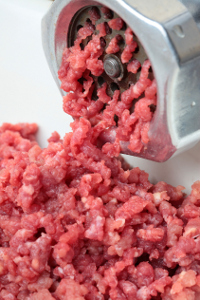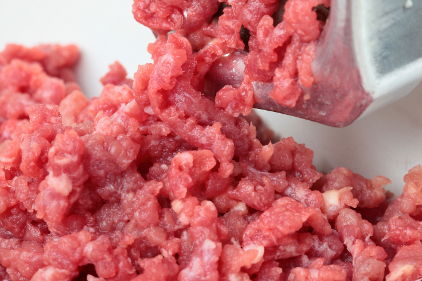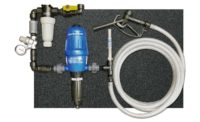 For machines that can last about 20 to 50 years, new innovations make big ripples.
For machines that can last about 20 to 50 years, new innovations make big ripples.Today’s new stuffers and grinders highlight their versatility and ability to work together to provide a continuous system that integrates all processing actions for improved efficiencies. New stuffers, for one, are fitted with vacuum tops that pull any type of meat product in to the machine without long interruptions.
“Processors are able to take advantage of the vacuum’s benefits, as well as making a more continuous process than what has typically been a discontinuous process,” says Jeff Sindelar, assistant professor and extension meat specialist at the University of Wisconsin, Madison, Wis. “A more continuous system promotes more speed and efficiencies.”
Stuffers also are matching more closely to the filling systems, so they can use different co-extrusion applications and match thermal-processing equipment.
“It’s a little bit of a stretch, but stuffing equipment needs to work in unison with thermal equipment,” he says. Product damage and smearing (of the fat under the casing) is always a concern during the stuffing process because “you’re taking a dense product, putting pressure on it and pushing it through holes and orifices,” says Sindelar.
He notes that generally grinding, stuffing and mixing are not designed to improve the product but maintain it during processing.
“For all of these [machines], the goal is to have zero product loss or negative product improvements,” he says. In addition, stuffers are still reliant on regular maintenance.
“How stuffers perform depends on how they are serviced,” says Sindelar. “If they are getting old and cracked or the computer malfunctions, they will affect the product.”
Elmwood, Wis.-based Sailer’s Food Market & Meat Processing Inc. replaced its stuffer about 10 years ago, and its owner, Jake Sailer, notes that equipment manufacturers are trying to make the maintenance process easier every year.
“The manufacturers come in every 1,000 hours — every 2,000 hours for larger stuffers — and try to help you the best they can,” he says. “They are also building them so they require less maintenance.”
Grinders become more flexible
Grinders are still essentially a simple piece of equipment: one or two screws, paddle, knife, plate and auger.
“But it’s interesting how complex or efficient those simple parts can be to processors,” says Sindelar. “It can be difficult to adjust the grinder speeds to maximize quality and throughput because of the size, ability and sheer mass of components to manage so many sizes of raw materials — whether they are fresh, frozen or semi-frozen,” he says.
In-line grinding systems feature the ability to have vacuums and grinding capability, so product can be ground and portioned in a single step.
He points out that their new technology today is heavily slanted to improved food-safety design.
“Any time equipment is redesigned — and offers more flexibility with applications — there is always an opportunity for food safety to be re-evaluated,” he says, noting the less raw product is handled, the better.
Kensington Lockers replaced its 20-year-old stuffer about two years ago with a similar version that fits well into their system, but added a double clipper machine to attach to the stuffer and automate packaging, says Wayne Beckman, owner of Kensington Lockers, based in Kensington, Kan.
“It makes chubs in ground beef or sausages, and interfaces well with our stuffer,” he says. “The equipment makes a nice looking package and saves time.”
Indeed, stuffers and grinders are interacting nicely and offering a variety of product applications for processors to consider.
“With our business growing and labor and quality of product to consider, I would like two grinders — one to first do a coarse grind then switch to a fine plate — or I think a grinder with a dumper on it would be useful,” says Sailer. “We could grind, mix, stuff, clip and be done — getting the final grind through the stuffer.”
Coarse and finely ground products have shifted a little bit in consumers’ perceptions, but still have equally broad interest. Coarse grinds are in demand by consumers wanting an Old World-type product, notes Sindelar, which is thought of as being smoked and slowly cooked.
“Fine grinds have morphed into lower-cost products like frankfurters or emulsified bologna,” he says.
Of course, new stuffers and grinders come with a cost — roughly about $150,000.
“In-line grinders and improved stuffers have been around for a few years, but not a lot of plants have them due to their costs,” says Sailer. “However, I wouldn’t be afraid to say that they pay for themselves in five years, because they save labor and other costs.”




Report Abusive Comment